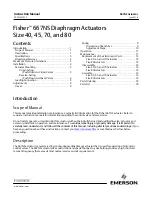
Instruction Manual
D102603X012
667NS Actuator
June 2018
9
Adjustments
Travel
WARNING
When moving the actuator stem with diaphragm loading pressure, use caution to keep hands and tools out of the actuator
stem travel path. Personal injury and/or property damage is possible if something is caught between the actuator stem and
other control valve assembly parts.
Make travel adjustments when the motion observed during actuator travel is different from the travel stamped on the
actuator nameplate. If the Actuator Mounting procedure was followed correctly, this adjustment should not be
necessary.
When adjusting travel of a direct‐acting (push‐down‐to‐close) valve, apply a low supply pressure to the actuator
diaphragm casing. This moves the valve plug off of the seat, reducing the chance of damaging the valve plug or seat
during adjustments.
1. Back the stem locknuts and indicator disk away from the stem connector, and slightly loosen the stem connector
cap screws.
CAUTION
Do not use wrenches or other tools directly on the valve stem. Damage to the stem surface and subsequent damage to the
valve packing might result.
2. Tighten the locknuts together, use a wrench on these locknuts, and screw the valve stem either into the stem
connector to lengthen travel or out of the stem connector to shorten travel.
3. Cycle the actuator to check the travel. If travel is not equal to the specified travel, adjust and check travel until
correct. Tighten the stem connector cap screws when correct travel is obtained.
4. Raise the travel indicator disk by threading the stem locknuts against the stem connector.
Spring
Discussion of Bench Set
The bench set pressure range is used to adjust the initial compression of the actuator spring with the actuator
assembly “on the bench”. The correct initial compression ensures that the valve‐actuator assembly will function
properly when it is put in service and the proper actuator diaphragm operating pressure is applied.
The bench set range is established with the assumption that there is no packing friction. When attempting to adjust
the spring in the field, it is very difficult to ensure that there is no friction being applied by “loose” packing.
Accurate adjustment to the bench set range can be made during the actuator mounting process (see the Actuator
Mounting Procedure) by making the adjustment before the actuator is connected to the valve.
If you are attempting to adjust the bench set range after the actuator is connected to the valve and the packing
tightened, you must take friction into account. Make the spring adjustment such that full actuator travel occurs at the










































